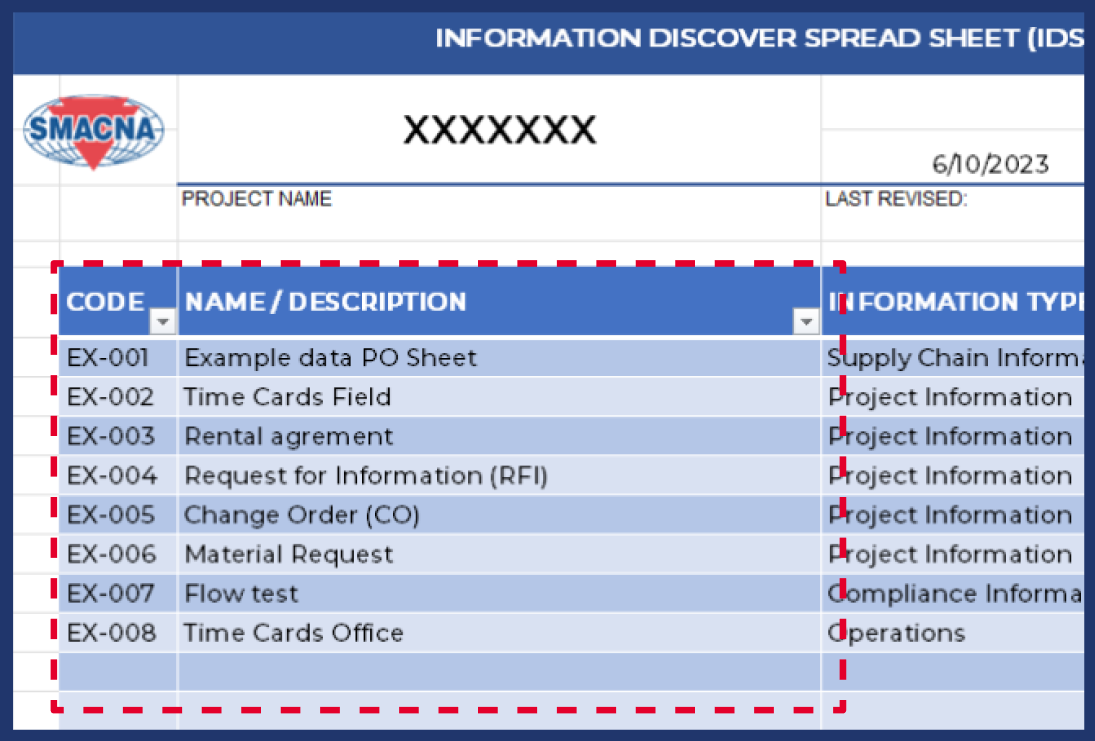Code - Name / Description
General
Below we walk through each area of information addressed in the IDS and providing best practices within those areas. It is important to remember to capture the current state (as-is) during the initial discovery survey of the information in your organization. This section will go through each attribute of the information and direct you to best practices providing you with a systematic way to improve the level of data stewardship within your company.
Code
 The code field can be customized to suit any internal naming structures that your company has. Its primary function will be helping in data organization and file naming structure. What's important to note is that that each piece of information that we collect has an associated unique code. While the type of information and data we are collecting is somewhat general in nature it is important that the code be unique. These codes will be primarily used by computers, not personnel. This makes the need for upper representative code less important. However, it is best practices to employ at least one letter and one number in each code (E.g., DA003 001_BAC). As codes are often used for file naming conventions it is also important to avoid symbols or characters. Including symbols and characters within codes is considered bad practices in file naming. (See Naming Convention)
The code field can be customized to suit any internal naming structures that your company has. Its primary function will be helping in data organization and file naming structure. What's important to note is that that each piece of information that we collect has an associated unique code. While the type of information and data we are collecting is somewhat general in nature it is important that the code be unique. These codes will be primarily used by computers, not personnel. This makes the need for upper representative code less important. However, it is best practices to employ at least one letter and one number in each code (E.g., DA003 001_BAC). As codes are often used for file naming conventions it is also important to avoid symbols or characters. Including symbols and characters within codes is considered bad practices in file naming. (See Naming Convention)
Name / Description
In this field we're looking to apply a name to the information type that we're identifying. This will be the common name or description used by people discussing the information (not a file name). Therefore, it is important to take care and use best practices when creating these descriptions and names.
You'll find that the biggest challenge is deciding how detailed to be or granular to be in the information you outlined in the IDS. Let's look at time cards for an example. The item is time cards and it could be identified in just one entry, for example “Timecards” or “Card”. Or it can be broken into more detail, such as “Card_employee”, “Card_date”, “Card_hours”, “Card_taskcode”, etc. It is recommended that the IDS be used with the most general level of detail (Timecards or Cards) and additional documentation to be used for component parts or parameters. Codes for greater detail and descriptions can often be combinations of the name and a specific parameter as in the examples. Codes can be adjusted in a similar manner, e.g., “TC_date_001”, “TC_hours_001”.
Best Practices
- Use Clear, Descriptive Names- The name of a data element or information should clearly indicate what it represents. Avoid using jargon or acronyms that may not be universally understood across the organization.
- Consistency- Stick to a naming convention that remains consistent throughout all data and information. For example, if you're naming a data field that represents "customer address," the similar field for suppliers should be named "supplier address," not "address of supplier."
- Avoid Ambiguity- Ensure that the names given to data elements and information are unambiguous. This includes avoiding homonyms (words that are spelled and pronounced the same but have different meanings) and maintaining a glossary of terms used.
- Categorization- Group related data elements or information together under broader categories. This makes it easier to find and manage related data. Where higher level of detail is required, categories can be combined with descriptive qualities of the data.
Understanding Good Stewardship
 Oftentimes descriptions and naming conventions can vary dramatically throughout an organization. These differences result in ongoing problems as the organization grows. Maintaining uniformity and understanding how individual types of data are being used within the company is important. Producing a cohesive chart similar to the one we are producing now will prepare your company for fast digital transformation and future growth by providing a cohesive guide for categorizing existing data, and introducing new data.
Oftentimes descriptions and naming conventions can vary dramatically throughout an organization. These differences result in ongoing problems as the organization grows. Maintaining uniformity and understanding how individual types of data are being used within the company is important. Producing a cohesive chart similar to the one we are producing now will prepare your company for fast digital transformation and future growth by providing a cohesive guide for categorizing existing data, and introducing new data.

